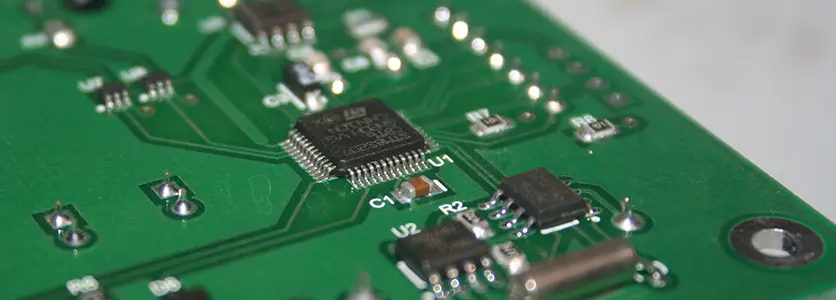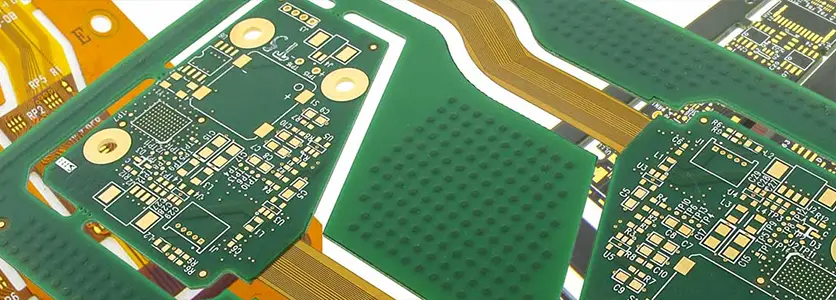
- On January 4, 2024
- In blog
Applications and Advantages of Rigid PCBs
Three types of printed circuit boards are rigid, flexible, and rigid-flex. The traditional rigid PCB served as the foundation for the development of the other two types, adapting to the evolving demands of the industry and market. Flex PCBs brought adaptability to PCB manufacturing, while rigid-flex PCBs merge these qualities to enhance performance. This article will provide a detailed introduction to rigid circuit boards, including more information about their advantages and applications.
What is Rigid PCB?
Rigid PCBs are the most common type of printed circuit board (PCB). They are made of solid, inflexible substrate material, such as fiberglass or epoxy resin, ensuring the circuit boards remain undeformed, with copper traces etched onto the surface. Rigid PCBs are typically used in applications where strength and rigidity are important, such as in computers, laptops, and smartphones.
In addition to their foundational role in electronic devices, rigid PCBs offer a high level of durability and reliability under various environmental conditions. This makes them ideal for use in industrial and automotive applications where they are exposed to harsher environments. The rigidity of these boards also allows for easier soldering and assembly processes, leading to more efficient production lines.
Types of Rigid PCBs
Rigid PCBs are versatile, suitable for a variety of project specifications and configurations. At Fastlink, we provide a selection of rigid PCB types, including:
Single-Sided: The foundational form of PCBs, single-sided circuit boards consist of one conductive material layer, with all components mounted on the same side. Their straightforward design allows for rapid manufacturing and minimizes production errors. Cost-effective, these boards are ideal for simple, low-density applications.
Double-Sided: These PCBs feature conductive copper layers on both sides, offering more space for components. This design enables more complex circuits and a broader scope of project suitability compared to single-sided PCBs.
Multilayer: Multilayer PCBs are composed of three or more conductive layers, with additional layers surrounding the core. These complex boards, through an advanced layering and curing process, reduce the need for external wiring. They are compact, robust, and optimal for space-sensitive and high-density circuit designs.
Advantages of Rigid PCBs
Rigid PCBs offer several advantages over other types of PCBs, including:
Durability and Reliability
Rigid PCBs are made from hard, sturdy materials like fiberglass or epoxy resin, which provide a solid foundation for the components. This structural strength ensures that the boards can withstand physical stresses and are less prone to damage during handling, manufacturing, and operation.
Ease of Fabrication and Assembly
The rigidity of these boards makes them easier to handle during the assembly process. Components can be easily soldered onto the board, and the risk of damaging the board during assembly is lower compared to flexible PCBs.
High Component Density
Rigid PCBs can support a high density of components and circuitry. This is especially beneficial in applications where space is a premium, such as in smartphones and other compact electronic devices.
Thermal Stability
Rigid PCBs typically exhibit good thermal stability, meaning they can withstand high temperatures without deforming. This is crucial for high-power applications and environments where the PCB is exposed to significant heat.
Cost-Effectiveness
For mass production, rigid PCBs are generally more cost-effective compared to flexible or rigid-flex PCBs. The standardization of materials and manufacturing processes makes them more affordable for large-scale production.
Consistent Quality
Due to their well-established manufacturing processes, rigid PCBs tend to have consistent quality and performance. This predictability is essential in industries where reliability is critical, such as in medical devices or aerospace applications.
High-Speed Circuitry Compatibility
Rigid PCBs are capable of supporting high-speed circuitry. They provide a stable platform for high-frequency circuits, which is essential in telecommunications and computing.
Environmental Resistance
Many rigid PCBs are designed to withstand harsh environmental conditions, including exposure to chemicals, moisture, and extreme temperatures. This makes them suitable for use in outdoor and industrial applications.
Difference between Rigid PCB and Flexible PCB

The evolution of electronics has seen a shift from the traditional use of rigid PCBs to the more adaptable flexible PCBs. While rigid PCBs have long been the mainstay in various electronic devices due to their sturdiness and reliability, their inability to bend or twist limits their application in more innovative designs. In contrast, flexible PCBs emerged as a solution, offering the essential versatility needed in modern electronics. This adaptability quickly made them a preferred choice among professionals seeking to push the boundaries of electronic design.
In terms of manufacturing, rigid and flexible PCBs share similar processes, but there are notable differences in their material properties and cost implications. Flexible PCBs demand extra care in handling and precise specifications to prevent issues like cracked solder joints when bent. Although individual flexible PCBs tend to be more expensive than their rigid counterparts, they can sometimes lead to lower overall project costs due to their space-saving design and reduced need for connectors. This aspect makes them particularly suitable for high-performance, compact devices like smartphones, cameras, tablets, and GPS systems.
An innovative approach in modern electronics is the combination of both rigid and flexible PCBs, creating products that harness the strength and durability of rigid boards with the adaptability of flexible ones. This hybrid design allows for a more dynamic application in electronic devices. While some flexible PCBs may resemble the design of rigid boards, they are distinct in their ability to provide flexible and space-saving solutions, often being implemented as single-sided PCBs. This blend of rigidity and flexibility is redefining the possibilities in electronic design, offering a balance between durability and innovation.
Uses of Rigid PCB
Rigid Printed Circuit Boards enhance circuit density, leading to a reduction in both size and weight of the board. The applications of rigid PCBs are as diverse as the electronics landscape itself. Here are just a few examples:
● Computing: From desktop PCs to laptops and smartphones, rigid PCBs form the backbone of these devices, connecting processors, memory, and other crucial components.
● Consumer Electronics: Televisions, cameras, game consoles, and more all rely on rigid PCBs for their internal circuitry.
● Industrial Applications: Power supplies, motor controllers, and various industrial equipment utilize rigid PCBs for their robust performance and heat management.
● Medical Devices: Pacemakers, defibrillators, and other critical medical equipment depend on the reliability and precision of rigid PCBs.
● Aerospace and Defense: Satellites, aircraft electronics, and military equipment often require the ruggedness and stability of rigid PCBs.
Choosing Between Rigid and Flexible PCBs
Rigid PCBs are generally less expensive than flexible circuits, but the overall cost of ownership can vary depending on the application. In some cases, using flexible PCBs may actually be more cost-effective. This is because flexible circuits can eliminate the need for additional components such as connectors, wire harnesses, and extra circuit boards. By reducing these elements, you not only cut down on material costs but also on labor, assembly, and scrap expenses. Therefore, a comprehensive evaluation of the total cost is essential to determine the most economical option.
In the realm of electronics, rigid PCBs are commonly used in a variety of devices, including laptops, desktop computers, audio keyboards, solid-state drives, flat-screen TVs and monitors, children’s toys, and other gadgets. Flexible circuits, on the other hand, are typically found in ultra-compact or high-performance devices such as GPS units, tablets, smartphones, cameras, and wearable technology. However, their application isn’t limited to just sophisticated devices. Low-tech applications like LED lights sometimes employ flex circuits as well, mainly for the ease of installation they offer.
Why You Need Rigid Circuit Boards from Fastlink?
Fastlink provides economical and robust rigid PCBs, perfectly suited for use in challenging conditions. These rigid PCBs ensure consistent shape and prevent distortion across a range of applications. Their natural versatility allows for various configurations, from single-layer to multilayer designs, tailored to meet specific size, material, and build requirements.
We offer high-quality rigid PCBs at competitive prices. Constructed from solid, inflexible materials like fiberglass, these boards can remain rigid, ensuring stability and performance.
Leave a comment